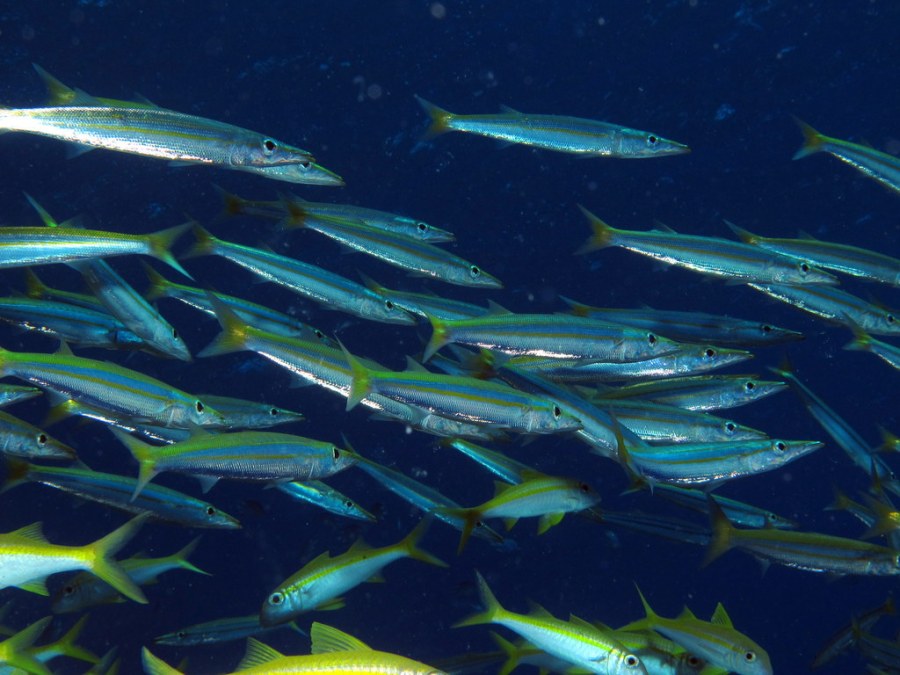Can You Put Goldfish in With Betta Fish

There are different stages of a immature fish's life. They are referred to past many names throughout the first years of their survival. Depending on the species will decide what stages and names a baby fish are referenced by. This can include egg, yolk-sac larvae, fry, and juvenile before reaching maturity.
Reproduction
There are three means for a fish to reproduce. This is either through livebearing, which is similar to the fashion humans and other mammals produce their immature, spawning, or cocky-bearing.
Spawning is the process when the female fish releases her eggs. The eggs are either deposited directly into the water, where they float around, or into a nest. This depends on the type of fish species. The male fish will then fertilize the eggs with milt that they release. Non all eggs that are laid volition be fertilized. Depending on the species of fish, the fish volition spawn every year, every iv years or only one time in their lifetime earlier dying.
Some fish can switch genders. This allows them to consummate the entire process of reproduction themselves. This process is also known as cocky-begetting.
Fertilized eggs hatch in two to eight days, depending on the species of fish. The bulk of eggs don't achieve maturity due to the dissimilar threats they face up. Some of these threats include the change in water temperature that tin can occur due to the irresolute seasons during spawning. Oxygen levels changing in the water is some other mutual threat to fertilized fish eggs. Flooding and sedimentation that carry the eggs to unhealthy areas or cause them to become landlocked will forestall the egg from hatching. Predators and disease are a constant threat to fish at all stages of their lifecycle.
Larvae
The larvae stage for a baby fish begins 9 to eighteen days after the egg has hatched. This is also called the yolk-sac stage equally the yolk-sac stays attached to the infant fish one time it is hatched. This yolk-sac provides the young fish with the nutrients it needs to abound within its environment. Some species of fish, such as the catfish, exercise not go through this stage.
The larvae stage of the baby fish'south life lasts 1 to two weeks. During this time, it feeds off the yolk-sac while staying at the bottom of the water. When in the larvae stage, many species of fish tend to settle within the plants and other caverns at the bottom of the water for protection. This helps them blend in and hide from predators as they don't have fins for swimming and are classified as gratis floaters.
Fry
Every bit a fry, a young fish still has its yolk-sac attached, but it begins to diminish in size. The fry phase lasts for two to five days for well-nigh types of fish. The fry will stay at the lesser of the water during this time. However, it does begin to explore its new surroundings, coming out of hiding for short periods of fourth dimension. Most of a fry's nutrition comes from the remaining yolk-sac, just it will brainstorm feeding on nutrient lying at the lesser of the h2o'southward bed.
Juvenile
Equally with each stage of a fish's life bike, the amount of fourth dimension the baby fish remains a juvenile depends on its species. This stage may last upward to 3 years. The juvenile fish begins to develop its fins, and their gills mature throughout this stage. Juvenile fish are not able to reproduce. The offset of the juvenile stage is crucial to the fish'due south survival, as it must learn how to survive amidst its predators, observe enough nutrient to survive and gain its independence in all other aspects.
Source: https://www.reference.com/pets-animals/baby-fish-called-4c866748e10f2345?utm_content=params%3Ao%3D740005%26ad%3DdirN%26qo%3DserpIndex
Post a Comment for "Can You Put Goldfish in With Betta Fish"